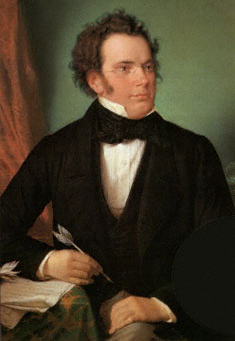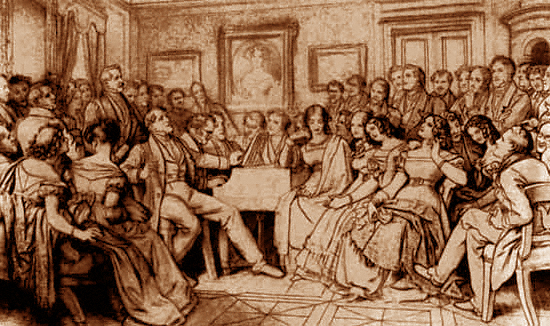

Franz Schubert (1797-1828), composed his String Quartet No. 13 in A minor, Op. 29 in 1824. Schubert was an Austrian composer and musician, and was the son of a schoolmaster. Although Schubert died at the young age of thirty-one, he was a prolific composer and wrote symphonies, piano works, chamber music, sacred vocal music and art songs (he composed over 600 art songs called Lieder). Although Schubert has been included in this Classical music section for chronological reasons, like Beethoven, Schubert was a composer who bridged the transition between the Classical and Romantic periods. Many music historians regard Schubert as an early Romantic composer due to his use of Romantic compositional techniques such as expanding Classical genres using harmonic color, highly expressive, beautiful melodies and innovative scoring.
When Schubert was young, he was accepted as a choirboy by the Imperial Court Chapel, which included a boarding-school education at the Imperial and Royal City College in Vienna. In addition to his regular studies, Schubert learned the violin and piano, and was a music pupil of the composer Antonio Salieri. Although many of Schubert's peers were required to join the military, Schubert was too short—he was smaller than the minimum height of five feet, thus he avoided the mandatory military conscription for Austrian citizens.
In 1813, Schubert left college, enrolled in a training school for elementary teachers, and in 1814, began teaching at his father's school. Although Schubert would have preferred to have had a full-time career as a composer, financial reasons apparently necessitated that he teach school, and he was only able to compose in his spare time. In 1818, Schubert procured a music teaching position as music master to the children of Count Johann Esterhazy in Hungary. This position gave him more freedom to compose, and by 1819, Schubert's reputation as a composer had increased to the point that he was able to earn a living through his music.
Schubert often met with his friends for domestic evening concerts of his music, gatherings that were called Schubertiades. The picture in figure 3.5 illustrates a Schubertiade with Schubert playing the piano, the singer Vogl on his right, and his friend von Spaun on his left. Quartet music was performed frequently at these informal Schubertiade concerts, and it is interesting to note that in the early 19th century, string quartet music was often composed for and performed by skilled amateurs or professional musicians playing for fun. During the Classical period, string quartets became an extremely popular form of composition. The term string quartet is often defined as a composition using a multi-movement form for four instruments, with the most common instrumentation being two violins, a viola and a cello. [3]

This piece is an arrangement of the second movement from Schubert’s String Quartet No. 13 in Am, “Andante.” Schubert based this movement on a theme he had already composed as incidental music for a play called Rosamunde, Princess of Cyprus. This quartet is nicknamed the Rosamunde Quartet due to Schubert's recycling of the theme. [4]
TECHNIQUE TIPS: The tempo for this arrangement of Schubert's second movement from his String Quartet No. 13 is andante, meaning, play the piece with a moderately slow tempo (andante is often considered to be a walking speed). Slurs are used throughout the flowing melody of this piece, and instances where slurs occur with dots over or under the notes indicate a slight separation should be used between the notes (the terms dotted slurs or slurred staccato are often used to describe this technique). Although the dynamics of this piece are predominantly soft (this movement begins with the designation mp, an abbreviation for mezzo piano which means moderately soft), dynamic contrast is found in sections with crescendo and decrescendo markings. Crescendo or cresc. means to gradually become louder, and is indicated by the sign:  , and diminuendo (dim.) or decrescendo ( decresc. or decr.), means to gradually become softer, and is indicated by the sign:
, and diminuendo (dim.) or decrescendo ( decresc. or decr.), means to gradually become softer, and is indicated by the sign:  . The piece ends with a fermata sign over the last note:
. The piece ends with a fermata sign over the last note:  . This sign indicates the note should be held and prolonged at the discretion of the performer or conductor (fermatas are also called a "hold" or the nickname "bird's eye").
. This sign indicates the note should be held and prolonged at the discretion of the performer or conductor (fermatas are also called a "hold" or the nickname "bird's eye").
© Copyright 2025 RK Deverich. All rights reserved.
Although this online violin class is provided free of charge, all rights are reserved and this content is protected by international copyright law. It is illegal to copy, post or publish this content in any form, and displaying any of this material on other websites, blogs or feeds is prohibited. Permission is given for individual users to print pages and perform music from this website for their personal, noncommercial use.